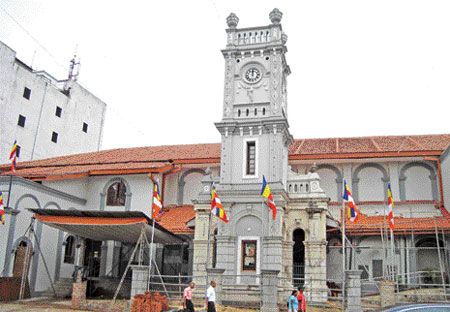
Tower Hall is 100 years!
The Tower Hall in Maradana, one of the very old landmarks of Colombo
is 100 years old.
It was opened at an auspicious time in the morning of December 6,
1911 by Anagarika Dharmapala, and that same evening, at 9.30 p.m. the
play Pandukabhaya was staged under the patronage and presence of the
Governor, Sir Henry MacCallum.
The play was written and produced by Charles Dias, one of the two
leading playwright - producers of the day. The other was John de Silva.
Going to the theatre was very popular then. It was the only form of
public entertainment 100 years ago; but there was no proper theatre or
play-house. The Tower Hall was the first and only proper theatre in the
whole of Ceylon, until the Lionel Wendt Theatre was opened in 1952, 41
years later.
 The
Tower Hall was built by G. Don Hendrick Seneviratna Appuhamy of
Heiyantuduwa, Kelaniya, on a land he owned in Panchikawatta, alongside
the Maradana railway station. The land was being used as a parking-lot
for horse-carts, the then mode of transport for people with money. The
Tower Hall was built by G. Don Hendrick Seneviratna Appuhamy of
Heiyantuduwa, Kelaniya, on a land he owned in Panchikawatta, alongside
the Maradana railway station. The land was being used as a parking-lot
for horse-carts, the then mode of transport for people with money.
Construction of the hall which began in 1909 was completed in 1911.
It was modelled on the Grand Theatre in Bombay. It had a proper stage
with curtains that could be drawn, a proper dressing-room and a balcony.
There were 1500 seats.
The clock tower which is its distinctive architectural feature has
given the hall its name Tower Hall. The tower is a copy of the tower in
London's Tower Bridge, across the River Thames.
It is said that it was Hendrick Appuhamy's third son, Edmund
Seneviratna, a theatre-fan, who persuaded the father to build a proper
theatre.
His son-in-law, Charles Dias' flair for play-writing and the
popularity of his plays must have given Hendrick Appuhamy the confidence
to go ahead with the project.
In 1833, the Elphinstone Dramatic Company of Bombay also known as
Baliwala Company staged plays in Colombo.
They were very popular and soon other theatre groups came over and
staged their own plays. Inspired by the plays of the Indians, our own
people began writing plays like those staged by the visiting theatre
groups and going to the 'teetar' (theatre) became very popular.
About125 years ago people had plenty of leisure but little to do in
their free time. No cinema to go to, no radio to listen to. Going to the
theatre was the main form of entertainment, not only for the moneyed
class. Some became addicts.
By the first decade of the last century, play-going was so popular
that there had been about 24 play-houses in Maradana and Pettah.
But there were no proper halls for staging plays. Some were wooden
sheds with thatched roofs and some were zinc sheds. One such hall was
called Belek Hall (Tin Hall).
Even John de Silva, was staging his plays in such make-shift halls.
When the Tower Hall was opened in 1911, he had been producing plays
for a full 20 years and drawing large crowds. Charles Dias was also
producing similar plays and they were as popular as John de Silva. These
plays are called Nrutti.
The Tower Hall, opened a new chapter in the history of Sinhala
theatre. From then on a play was staged every evening at the Tower Hall,
except for a short time in 1915, when the theatre was closed because of
communal riots in Colombo.
In the first ten years, the plays staged were mainly those written
and produced by Charles Dias - Padmavathy Vidura, Sivamma Dhanapala and
so on.
Mention Tower Hall and the name that comes to mind at once is John de
Silva. Tower Hall and John de Silva had become inseparable. But a full
ten years were to pass before a John de Silva play was staged at the
Tower.
He and his Arya Subodha Natya Sabha were staging plays in rented
halls, while Charles Dias and his actors, known as Arya Sinhala Natya
Sabha were staging two or three plays every week at the Tower Hall.
When Charles Dias couldn't cope with the demand, other play-wrights
were hired to write for the Arya Sinhala Natya Sabha.
The new theatre not only drew large audiences, but also drew players
from John de Silva's company. Actors must have found it very flattering
and very satisfying to play in this new and well-equipped hall. Equally
or more satisfying must have been the better terms of payment.
One by one, the small pay-houses closed and by 1927 the only
play-house, in Colombo, in fact in the whole island, was the Tower Hall.
John de Silva died in 1922 but his plays continued to be staged at the
Tower alternating with those produced by Charles Dias, drawing large
crowds until the 'Silent Pictures' took over. On 12, September 1931,
Tower Hall became Tower Cinema Hall, but plays continued to be staged,
not daily as before.
Nrtta popularised by John de Silva and Charles Dias gave way to a new
genre of plays. Many were adaptations of stories from Indian films.
Sirisena Wimalaweera's Rodi Kella, is an outstanding play of this genre.
Seebert Dias, father of dance-maestro Chitrasena took over the
running of Tower Hall for some time in the early thirties.
His role of Shylock in the Sinhala adaptation of Merchant of Venice
was, it is said, the talk of the town in the thirties and forties.
The arrival of the Minerva Players, headed by the Jayamanna brothers,
staging plays on contemporary themes, like Kadavunu Poronduwa (Broken
Promise) and Rukmani Devi's singing took away theatre-goers from the
Tower Hall. They had greater appeal than the plays of Wimalaweera, D. V.
Seneviratna, Organ Rodrigo, Bodhipala and others of this school.
Two or three years after Independence, an attempt was made with a
production of Vessantara by the artist J. D. A. Perera, to revive nrutti
and bring back theatre-goers to the Tower Hall. It was a dismal failure.
The 1950s Maradana was a crowded, untidy and unclean commercial hut
shunned by the leisured class and theatre-goers. But the Tower Hall was
there like a rock in Maradana, the clock striking the hour.
It was R. Premadasa, when he was Prime Minister who resurrected the
Tower Hall and brought it back to its former glory. With a 40 million
yen grant given under the Japanese Government's Cultural Grant Aid
Programme, lighting equipment was installed, the hall repaired and
facilities upgraded.The front verandah was made a picture-gallery with
photographs of playwrights, producers, actors and actresses of Tower
Hall's hey-day.
The born again Tower Hall was opened in September 1989 with the
staging of Siri Sangabo, a nrutti by John de Silva, produced by Henry
Jayasena.
Once again plays were staged, girls performed their arangetrams,
pre-schools had their year-end concerts and there were musical shows at
the Tower.
I remember watching school children presenting nrtta. It was an
inter-school competition. I can almost hear a school-girl from Galle
singing 'Govey genu lassanai.'
I do not know what the play was. If my memory is correct, that school
carried away the prize.
The Tower Hall was refurbished once again in 2008-9. New chairs
replaced the old ones which were damaged, and a another dressing room
added. The new chairs being bigger and more comfortable the hall can now
seat only 850; earlier it was 1500.
The Tower Hall continues to be a venue for musical shows, plays,
dance performances and also for seminars for A.L. students, and the
clock continues to strike the hour. But the Tower seems to be a poor
relation of its neighbour Elphinston which is now the more popular venue
for dramas and cultural shows.
-Sumana Saparamadu |

